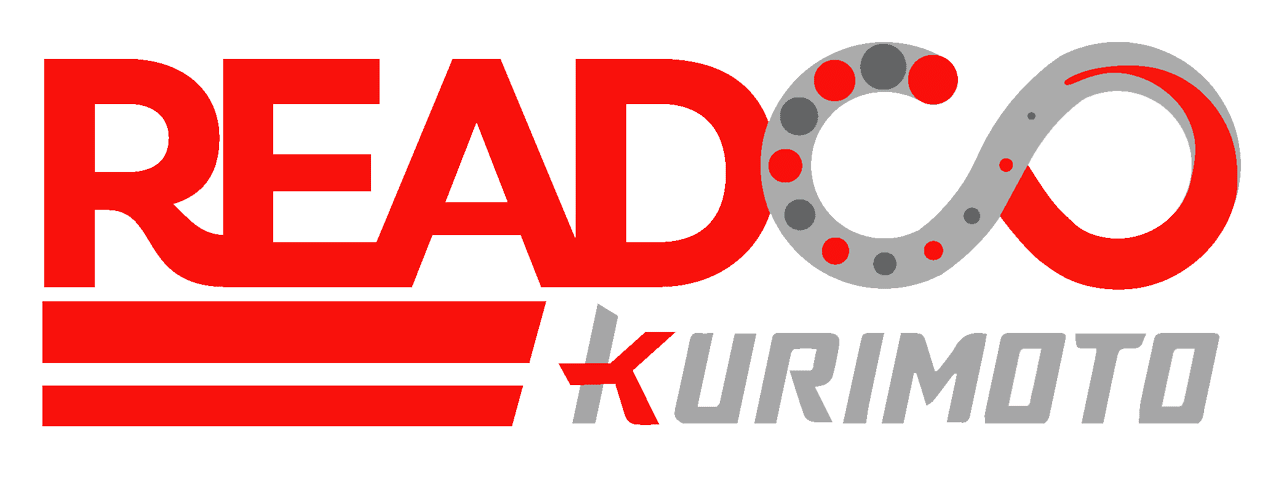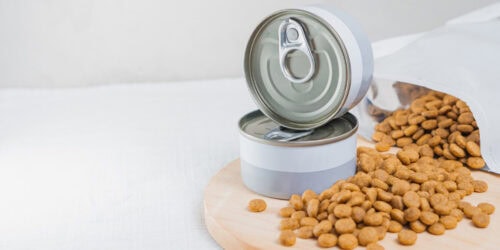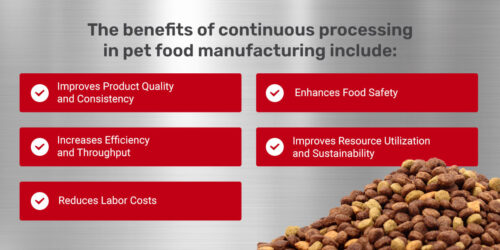How Continuous Processing Can Improve Pet Food Manufacturing
Comments Off on How Continuous Processing Can Improve Pet Food ManufacturingThe pet food industry is strong, and consumer spending on pets continues to rise. A strong market leads to greater competition and market saturation — to remain successful, pet food manufacturers need to keep up with demand while overcoming hurdles like supply chain disruptions, labor challenges, and recalls.
One way they can do that is by investing in continuous processing equipment. Continuous processing in manufacturing means materials flow continuously through the production process from raw materials to finished product. This differs from batch manufacturing processes in many ways, most notably in its ability to facilitate nonstop production.
In pet food manufacturing, continuous processing is an effective way to scale up production and decrease labor cost, without compromising on quality. Learn more about how to improve pet food manufacturing efficiency with continuous processing.
The Challenges of Traditional Pet Food Manufacturing
The traditional batch processing method for pet food manufacturing involves gathering the ingredients needed for a single batch, mixing, preparing, and cooking them, and then further processing and packaging. Once one batch is complete, the process starts again for another batch. This process is effective for small-scale operations or ones that require switching between multiple different recipes, but it may not work well for high-demand environments.
A few limitations and challenges associated with traditional batch processing include:
- Inconsistent product quality: Traditional pet food manufacturing transitions from one batch to another, meaning there’s more room for error. Stopping and starting production can cause slight variations in ingredients, mixing, cooking and processing that lead to inconsistent product quality. In cases like prescription pet food diets, precise control over ingredients is essential.
- High labor costs: Batch processing is not automated, requiring more costly manual labor. Staff need to supervise the incorporation and mixing of ingredients, monitor the cooking process, and then transition back to the first step for the next batch.
- Long production cycles: Because each batch is handled separately, batch processing often results in longer production cycles. When each batch takes longer to produce, it can impact efficiency and decrease output.
- Difficulties in scaling up production: While batch processing is effective for smaller operations, it makes increasing production difficult for large-scale manufacturing.
- Potential for contamination: Batch processing requires the transfer of materials from one process to another, increasing the safety risks. Meanwhile, continuous processing happens in an enclosed system, reducing the chances of contamination.
How Does Continuous Processing Improve Pet Food Manufacturing?
With the pet food industry booming, manufacturers need to add product lines, diversify offerings, and increase operations to satisfy demand. Continuous processing technology is essential to stay competitive and meet these increasing demands.
The benefits of continuous processing in pet food manufacturing include:
Improves Product Quality and Consistency
Continuous processing improves pet food manufacturing by ensuring consistent mixing, heating, and cooling, leading to uniform product quality. Precise control over process parameters, such as temperature, shear, and moisture content, is the only way to produce a consistent product at a large scale.
Even small variations in ingredients or cooking can impact the final product. For example, binders — like starches, flour, and proteins — play an important role in pet food quality by controlling shrinkage, moisture, and fat loss during processing. Incorrectly measuring the binding agents in one batch can result in a product that falls apart during packaging.
When pets and pet parents notice decreased product quality, it also leads to higher requests for returns and decreased customer satisfaction. Consistency is key to keeping customer loyalty and maintaining a positive brand reputation.
Increases Efficiency and Throughput
Batch-to-batch transfers require higher cycle times and reduce throughput. Meanwhile, continuous processing creates a more streamlined and efficient production process. Raw ingredients are continuously fed into the production line, which means a continuous output of finished products.
With automated process control and monitoring, any defects can be caught early. Rather than affecting an entire batch and halting production, staff can quickly address the problem while production continues.
Reduces Labor Costs
Increasing production while reducing costs is vital for continued success in any competitive market. For the pet food industry, continuous processing reduces the need for manual labor, allowing facilities to retain fewer staff and leading to significant cost savings. Employees can instead focus on more essential duties while the equipment operates independently. Continuous processing enhances safety for employees by eliminating lifting of heavy bags of materials. The closed design of a Continuous Processor keeps employees safe from moving machine parts and reduces slippery product spills on the manufacturing floor.
Enhances Food Safety
Continuous processing minimizes the risk of contamination by reducing the number of open transfers and handling steps. Using a closed-loop system, the raw ingredients are fed into the system at the first step and require minimal to no handling afterward. This process makes it easier to follow pet food safety regulations and demonstrate compliance during inspections.
Continuous processing machinery can implement automated cleaning and sanitation procedures, decreasing the risk of contamination. This process also allows for a higher degree of monitoring, as staff can quickly identify potential risks before they become problems.
Improves Resource Utilization and Sustainability
Continuous processing reduces waste and improves the utilization of raw materials, water, and energy. With more streamlined processes and higher efficiency, it cuts down on energy and resource consumption. Compared to batch processing, continuous manufacturing has a lower environmental footprint and leads to less waste.
Continuous Processing Technologies for Pet Food Manufacturing
Continuous processing can work for various pet food products, including:
- Dry kibble.
- Canned wet food.
- Pouched wet food.
- Freeze-dried foods.
- Treats like biscuits, chews, and jerky.
- Certain pharmaceuticals and nutraceuticals.
- Adding blueberries, peas, or protein chunks into the above items to improve visual appearance
Equipment and machinery that pet food manufacturers use include:
- Continuous mixers: Continuous pet food mixers ensure consistent and homogeneous mixing of ingredients, with high speed and excellent consistency.
- Continuous extruders: Single-screw and twin-screw generate high pressure which cook, shape, and texturize pet food products. Twin screw continuous mixers excel at dispersion and often improve total throughput when used to feed an extruder.
- Continuous dryers: Dryers used in pet food manufacturing include twin screw continuous reactors, fluid bed dryers and belt dryers. They remove moisture from pet food products to improve shelf life.
- Continuous coating systems: These systems apply coatings to pet food products to enhance flavor, appearance, and nutritional value.
Ready to Transform Your Pet Food Manufacturing?
Readco Kurimoto produces the best continuous pet food manufacturing equipment, enabling you to scale operations and maintain the high quality your customers expect. Our machines comply with stringent standards set by the Food and Drug Administration (FDA), the American Society of Mechanical Engineers (ASME), and the Association of American Feed Control Officials (AAFCO).
Readco Kurimoto’s continuous processor equipment is designed to withstand tough operating conditions while ensuring homogenized mixtures. Our process development laboratory is committed to ensuring your equipment operates as intended, performing extensive testing to verify it can operate at scale and integrate seamlessly into your operations. We also improve product tracing with advanced controls for input monitoring.
Tell us about your requirements, and we’ll find a solution that suits your operations.
What Are Continuous Hybrid Reactors, and How Do They Work?
Comments Off on What Are Continuous Hybrid Reactors, and How Do They Work?
There are many approaches to manufacturing, ranging from repetitive to discrete processing. One of the most common methods is continuous processing, where production continues without stopping and creates the same products repeatedly. This option has many advantages, including greater control and efficiency. Depending on the application, manufacturers can use different continuous reactors to facilitate the process.
While various industries can benefit from continuous processing alone, incorporating other methods can be beneficial. A continuous hybrid reactor (CHR) offers the best of both options in one machine. Learn more about continuous processing versus batch processing, what CHRs are, and how different industries can apply them in our guide.
Understanding Continuous Processing
In continuous processing, production is ongoing and begins with raw materials. Once the materials are fed into the system, they go through the manufacturing process without breaks, emerging at the end as final products. This approach differs from batch processing, where the production run is broken down into stages using a containerized batch mixer. Every stage must be completed before the batch can move on to the next.
The main advantage of continuous manufacturing is that it supports high-volume production. This process relies on a continuous processor system, which comprises highly automated equipment that creates greater consistency and efficiency.
For example, in the food industry, continuous processing improves quality control, food safety, and flexibility — the process is constantly being monitored to identify issues and ensure accuracy.
One type of continuous processor is a continuous reactor. This equipment is specifically designed for carrying out chemical reactions in a continuous flow, facilitating chemical transformation. Some examples of reactors include:
- Continuous stirred-tank reactor (CSTR): CSTRs are often used for liquid-phase reactions. A CSTR mixes the reactor’s contents perfectly, resulting in a uniform composition throughout the vessel. As reactants are continuously fed into the reactor, products are withdrawn, and the effluent stream is removed.
- Microreactor: Often used for fast reactions, high-throughput screening, and reactions involving hazardous materials, microreactors have very small channel dimensions. This small size creates a high surface area-to-volume ratio. As a result, the continuous processor has effective heat transfer and precise control over reaction conditions.
- Plug flow reactor (PFR): These reactors generally offer higher conversion rates than CSTRs for the same reactor volume. In a PFR, the fluid flows through a cylindrical tube or channel in a “plug” or “slug” flow pattern, with minimal axial mixing. The fluid’s composition changes as it flows.
Today’s continuous reactor systems feature static mixers, dynamic mixers, ultrasonic mixing, and similar components to improve mixing efficiency and mass transfer. For example, in biodiesel production, novel reactors are being designed to enhance mixing rates with a multifunctional process intensifier. These continuous reactor innovations are helping companies benefit even more from continuous processing.
What Is a Continuous Hybrid Reactor?
A CHR combines the features of both a batch reactor and a continuous reactor. It uses a deep vacuum to facilitate chemical reactions, giving a high level of control over residence time, heat transfer rate, and other reaction conditions. Depending on the use case, a CHR can facilitate a chemical reaction, evaporation, devolitolization, degassing, drying, and other processes to create powder, flake, paste, or slurry in a single step.
This type of self-contained processor has twin, co-rotating, hollow paddle shafts set in a closed, jacketed barrel. It generally has the following interior and exterior components:
- Interior: Primary vacuum ports, secondary vacuum ports, an area under vacuum, a process area, and a product discharge area
- Exterior: Vacuum ports, a material feed inlet, multiple liquid injection locations, vacuum/vapor removal, cored shafts, a jacket heating and cooling medium, and a product discharge area
As processing begins, the primary reactants are continuously inserted through the feed and injection ports. Once they’re inside the barrel, the chemical reaction begins, and mixing and heat enhance the process.
Then, the vacuums remove byproducts, and the final product is discharged. The process happens continuously as the reaction takes place.
Continuous hybrid reactor benefits include enhanced control, improved yield, and greater flexibility compared to traditional batch reactors. This machinery excels at deep vacuum, heat transfer, mixing, reactions, and waste reduction.
Applications of Continuous Hybrid Reactors
Manufacturers in many industries use CHRs in their process development laboratories, and production lines. This device’s main applications include processing high-viscosity, temperature or oxygen sensitive materials, such as sealants.
See how an advanced continuous hybrid reactor can be applied in various industries:
Pharmaceuticals
When synthesizing active pharmaceutical ingredients and their intermediates, companies require controlled environments for product quality and consistency. CHRs excel at providing precise control over reaction conditions. As a result, variability is minimized between batches. Additionally, a CHR’s smaller reaction volume can improve safety, especially when dealing with highly reactive or unstable processes.
Chemicals
Those working with high-viscosity chemicals know they can be difficult to handle. A CHR makes that easier by processing “sticky” chemicals, even in a deep vacuum environment. Examples include polyester, acrylic resins, polyamide resins, and vinyl acetate resins. CHRs also provide high levels of consistency across batches and reduce the creation of unwanted by-products.
Food and Beverage
This industry requires high levels of quality control and flexibility. CHRs are ideal for fermentation, drying, and dehydration, providing control over reactions and temperature. Compared to batch processing, CHRs can provide food and beverage businesses with greater efficiency.
Other Industries
Many other industries can use CHRs to achieve better quality control and flexibility. For example, CHRs could be used in the wastewater treatment process by continuously cultivating microbial cultures to break down pollutants. CHRs can also produce consistent mixtures, which is ideal for creating engineered fuels and composites.
The Continuous Hybrid Reactor From Readco Kurimoto
Readco Kurimoto’s continuous hybrid reactor is built to deliver safe, efficient, and repeatable chemical reactions to suit your processing needs. Through high vacuum capability, high-temperature-rated construction, and other elements, our proprietary design can help you transform raw materials using the best aspects of both continuous and batch processing.
Based on your use case, you can make continuous hybrid reactor upgrades to suit your specifications. For example, the paddle can be sized and changed as needed to support various industrial applications, which makes scaling your operations easier. The CHR’s internal volume can also be built up to 978.6 cubic feet. Whether you are in need of drying or degassing capabilities, or something in between, our CHR is built for the task.
Learn more about our CHR and other processor and mixer products.
Why Choose Readco Kurimoto?
At Readco Kurimoto, we have decades of experience helping companies improve their products with advanced continuous mixing machines. With extensive knowledge in process development testing, we have partnered with numerous small and large companies across industries, such as food, chemical, specialty materials, and building.
If you are searching for high-quality, reliable continuous processing equipment, our team is here to assist. Contact us today to get started or discover more about the latest continuous hybrid reactor technology.

 Engineered and built in the United States of America
Engineered and built in the United States of America





